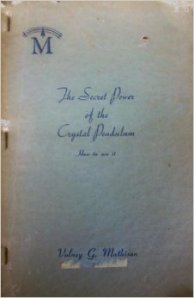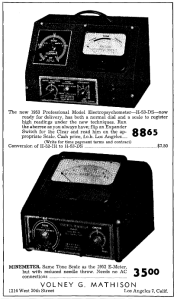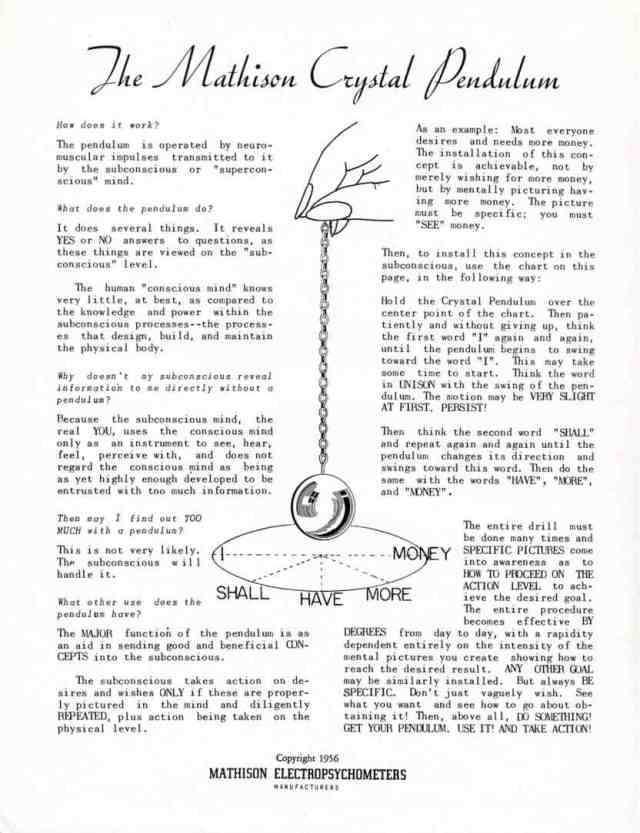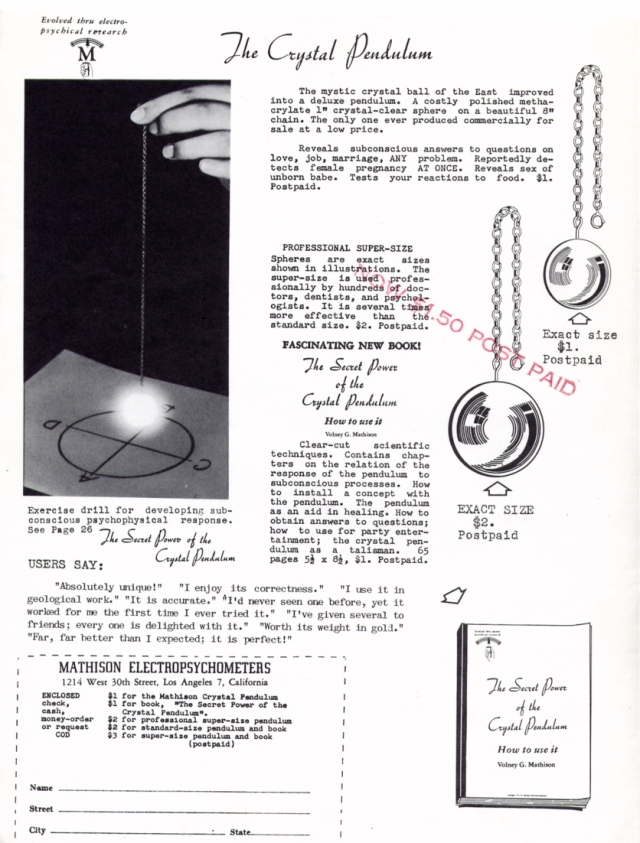 Volney Mathison emerges as a man who was energetic, ingenious, inventive and technically competent.
Volney Mathison emerges as a man who was energetic, ingenious, inventive and technically competent.
In the 50’s, when science was performing miracles, his impressive-looking e-meters must have lent great credibility to the claims he made for his own “Creative Image Therapy” and for L Ron Hubbard’s “Scientology”.
The problem, of course, is that no matter how wonderful his machines were, the theory that they were based on was simply wrong. All that an e-meter can measure is a small decrease in the electrical resistance of the skin. While this often accompanies a state of arousal, knowing this is of little practical use to a psychotherapist.
Simply put, ‘arousal’ means that you are stimulated by your environment. You could be having the most profound insight – or thinking about the moment when you stubbed your toe on the way to the doctors office.
The wonderful variety of Mathison’s e-meters disguises the fact that their supposed ability to “objectively confirm” what is said by a client to their therapist has no rigorous theoretical foundation at all.
The justifications Mathison offered for his e-meter were based on magical thinking – and if that seems harsh, today we will examine a two-page advertisement for another product that Mathison distributed for profit – a “Crystal Pendulum”.
This is, nakedly, the same thing used for centuries for magical divination. Mathison attempts to ‘modernise’ it with the pseudo-scientific use of ‘technical’ terms drawn from real medicine and from psychoanalysis.
Conceptual Parallels with Dianetics and Scientology
It does not take too much imagination to see that many of the ideas Mathison used to justify the claims he made for his pendulum are also basic concepts in Dianetics and Scientology.
The pendulum is operated by neuro-muscular impulses transmitted to it by the subconscious or “super-conscious mind”
like the e-meter, the pendulum is supposed you in touch with a hidden, and powerful aspect of your self.
[…] the subconscious mind, the real YOU, uses the conscious mind only as an instrument to see, hear, perceive with, and does does not regard the conscious mind as yet highly enough developed to be entrusted with too much information.
Mathisons subconscious (or super-conscious) mind sounds a lot like the “analytical mind” that Hubbard introduced in Dianetics – infinitely powerful, but unavailable to us without the use of special techniques.
Also, Mathison’s insists that the pendulum will only work if the user rigorously and repetitively ‘drills’ themselves in its use (‘drills’ and repetitive ‘processes’ have always been a prominent feature of Scientology practice).
The subconscious takes action on desires and wishes ONLY if these are properly pictured in the mind and diligently REPEATED.
Mathison’s insistence on a very particular procedure provides a defence against accusations that his pendulum does not ‘work’ – you were not operating it properly. This defence is also used in Scientology – Scientologists will claim that Scientology always works, when properly applied, so the only reason for failure is that the student has not followed the instructions.
 Of course, Mathison has a solution on page two (below) – send another dollar to buy his book! Scientology can also ‘recover’ your failures – with further paid courses.
Of course, Mathison has a solution on page two (below) – send another dollar to buy his book! Scientology can also ‘recover’ your failures – with further paid courses.
The second page of the advertisement (also below) continues to play the science card in its description of Mathisons book, “The Secret Power of the Crystal Pendulum: How to use it”.
It claims that the book includes:
Clear-cut scientific techniques. Contains chapters on the relation of the response of the pendulum to subconscious processes.
Perhaps Hubbard’s ideas what not as original as they seemed – perhaps he, also, adopted familiar ideas from old superstitions and dressed them up in a new, pseudo-scientific, suit of clothes.
Mathison certainly worked hard to disassociate his pendulum from ‘obsolete’ ideas like divination and spiritualism and associate it with science and technology.
 Above the photograph on the second page, showing the pendulum is, the same logo (featuring a stylised meter) that Mathison used on his e-meters. It asserts that that the pendulum was “Evolved thru electro-physical research”.
Above the photograph on the second page, showing the pendulum is, the same logo (featuring a stylised meter) that Mathison used on his e-meters. It asserts that that the pendulum was “Evolved thru electro-physical research”.
Both Mathison and Hubbard constantly appealed to the perceived authority of “research”. The world’s largest research project had only recently brought atomic weapons into the world, and the word held great power. The public were not to know that the ‘research’ conducted by Mathison and Hubbard existed only in their imaginations.
Here’s page two:
In a final parallel with Dianetics and Scientology (unless you can find more) Mathison cannot resist piling on extraordinary claims without offering any evidence. Hubbard claimed that practising Dianetics would enable people to correct their eyesight, develop a perfect memory, improve their IQ and even grow new teeth. Mathison claims that his pendulum:
Reveals subconscious answers to questions on love, job, marriage, ANY problem. Reportedly detects female pregnancy AT ONCE. Reveals sex of unborn babe. Tests your reactions to food.
Presumably one of the pendulums few failures was its inability to detect male pregnancy. Luckily, this is not a serious flaw.
Mathison Finds His Mark – With the E-meter
The crystal pendulum does not seem to have been a best-seller in Mathison’s product range. It’s origins in superstitious practices like divination were surely too obvious to sit well with a radio engineer and pulp science fiction writer.
 Mathisons e-meter must have been both more congenial to him, and were certainly more successful because it looked like a technological device and had no associations with superstitious practices – in fact it must have powerfully suggested the power of accuracy of the new science that was currently emerging into public consciousness.
Mathisons e-meter must have been both more congenial to him, and were certainly more successful because it looked like a technological device and had no associations with superstitious practices – in fact it must have powerfully suggested the power of accuracy of the new science that was currently emerging into public consciousness.
People did not understand how it worked – but they did not understand how radio worked either. They accepted Mathison’s fringe therapeutic ideas more readily when faced with this technological prop. Unfortunately, the ideas behind it were still based on the same disguised magical thinking which he used to ‘explain’ the operation of his pendulum.
Mathison’s efforts with the pendulum were not wasted – he learned how to promote a product. For example, his pendulums came in ‘standard’ ($1) and “professional” ($2) versions. The “professional” version was twice the size, and he took the name seriously.
The super-size is used professionally by hundreds of doctors, dentists and psychologists. It is several times more effective that the standard size.
Mathison used this same promotional technique later in his range of ‘standard’ and ‘professional’ e-meters. However, he offered no explanation as to why, in the case of crystal pendulums, ‘size matters’.

